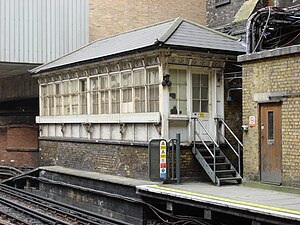Liverpool Street interlocking machine room
| Liverpool Street IMR | |
|---|---|
| OD | |
 | |
| Overview | |
| Opened | 1 February 2021 |
| Closed | 6 March 2021 |
| Operator | London Underground |
Liverpool Street (prefix OD) is a Grade II listed Interlocking Machine Room (IMR) and former signal cabin located in the station of the same name on the Circle, Hammersmith & City and Metropolitan lines of London Underground’s Sub-Surface Railway (SSR). Opened in 1875, re-fitted in 1910, 1954 and converted to an IMR in 1956, it closed on 6 March 2021 as part of the Four Lines Modernisation (4LM) re-signalling programme.
It is not to be confused with the former signal cabin located on the Central line within the same station at Deep Tube level.
Metropolitan Railway
Liverpool Street signal cabin opened with the Metropolitan Railway’s (MR) dedicated station at Bishopsgate on 1 February 1875.[1] For the first year of the extension east of Moorgate, MR trains had run into the Great Eastern Railway (GER) station.[2] The signal cabin was equipped with a lever frame of 40 levers. In keeping with early Underground signal boxes, it mimicked mainline railway companies of the period with gabled canopies and intricate woodwork officially classified as a C-19 design.[3] The connection with the GER was lifted in 1907 and Bishopsgate was renamed to Liverpool Street in 1909 shortly before a new lever frame (20 levers) was installed when bay platform 3 was brought into regular use in 1910. The signal cabin gained its first prefix identification of G by 1912.
London Transport
On 21 February 1954, Liverpool Street signal cabin was re-lettered to prefix OD and an electrically interlocked Westinghouse ‘B style’ miniature lever frame replaced the existing frame within the confines of the existing building.
Liverpool Street signal cabin along with Barbican signal cabin (prefix OG) were converted to remote operation as an IMR being controlled from Farringdon signal cabin (prefix OH) from 12 December 1954. The idea behind this was to concentrate signalling control where track layouts were now rationalised enough to make remote operation by push button desks by a single signaller feasible. Prior to the 1950’s, the railway between Farringdon, Barbican and Liverpool Street had extensive goods sidings and spurs necessitating local signal cabins. Whilst some of these were still operational, they were nowhere near in scale or complexity compared to the previous decades and goods traffic would continue to decline into obsolescence by the 1970’s.
During the 1980’s, bay platform 3, the main factor in the complexity of track and signals in the Liverpool Street SSR area, was taken out of use to provide office space for the rebuilding of Liverpool Street Main Line station. Once the offices were dismantled, the decision was taken not to re-commission the bay platform and the track layout was subsequently rationalised. This left just one shunt signal, a crossover and two signals in the control area of Liverpool Street IMR.
Farringdon signal cabin itself was converted to an IMR with its control area being absorbed into Baker Street Service Control Centre (SCC) on 28 November 1999. Barbican IMR had been abolished in 1979 following the removal of all crossovers in the area. Liverpool Street IMR remained however with remote control passing to Baker Street SCC on 25 March 2001. The decisions to abolish platform 3 and not re-align the remaining crossover meant that unusually for the Underground, the points are located within the station platforms. This rendered them unusable to trains in passenger service that were longer than a 6-car train of C69/77 stock bar extreme emergencies.
Four Lines Modernisation
The replacement of the C stock with longer S stock trains further reduced the usability of the crossover now only being able to be traversed in the reverse position whilst out of service. Despite the operating difficulties in having a crossover fouled by trains berthed in both platforms, the crossover was fully incorporated into Communications Based Control (CBTC) in preparation for 4LM. Transition from legacy fixed block signalling to CBTC on the SSR was split in 14 Signal Migration Areas (SMA) of which Liverpool Street fell into SMA 3 concerning the railway between Euston Square, Monument and Stepney Green.
After intensive testing and a series of aborted go-live dates, Liverpool Street IMR will close after close of traffic in the early hours of 6 March 2021, after 146 years of occupation. SMA 3 will subsequently enter revenue earning service the following day.
Liverpool Street IMR gained Grade II listing by Historic England in 2013 and as such is protected from unsympathetic redevelopment or demolition.
References
- ↑ Bownes, David; Green, Oliver; Mullins, Sam (2012). Underground : How the Tube Shaped London. Allen Lane. ISBN 978-1-846-14462-2.
- ↑ Smith, Denis (2001). London and the Thames Valley. Civil Engineering Heritage. Thomas Telford. ISBN 0727728768.
- ↑ Historic England. "SIGNAL BOX AT LIVERPOOL STREET LONDON UNDERGROUND (1574542)". PastScape
